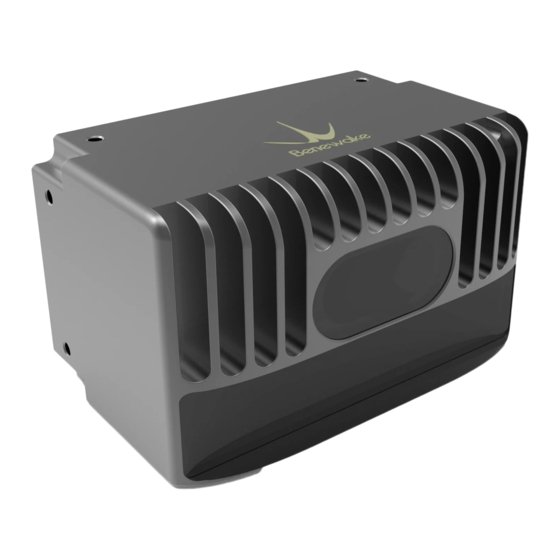Summary of Contents for Benewake CE30-C
- Page 1 CE30-C Solid State Array LiDAR Operation Manual Benewake (Beijing) Co., Ltd. Page...
-
Page 2: Table Of Contents
Table of Contents CE30 Introduction ..............................3 Indicator Instruction .............................. 4 Software Operation Instruction ..........................4 Description on Line Sequence ..........................6 Installation Instruction ............................6 Method of Center Calibration ..........................7 Head Dissipation Component and Reference Design ................... 8 Application Case .............................. -
Page 3: Ce30 Introduction
1. CE30 Introduction CE30 is an IR DE-LiDAR developed on the basis of ToF principle. With the optimized obstacle avoidance mode, the detecting region of interest can be set up. The single-point projection distance of the nearest obstacle can be transferred through CANBUS. -
Page 4: Indicator Instruction
2. Indicator Instruction Blue light: ready state, ready for connection and running Blue flash: running state Red flash: missing of relevant running files Red light: fatal error (abnormal signal, abnormal interface communication, abnormal I2C, etc.) Fig. 2 Indicator Drawing 3. Software Operation Instruction Connect all the accessories in accordance with Fig. - Page 5 Fig. 4 Illustration of Software Functions Note ① The software could automatically identify two kinds of UART: one for data and another is for debugging information. Please choose appropriate UART number in accordance with computer properties. ② Default setting of obstacle avoidance area is 70 cm in width and 400 cm in depth. ③...
-
Page 6: Description On Line Sequence
Fig. 5 Illustration of Single-point Mode 4. Description on Line Sequence Fig. 6 Description on Line Sequence: Red - positive, Black - negative, Green - CANH, White – CANL Attention! Connect with CAN interface before power supply. Current of power adapter shall be above 2A. During energization of LiDAR, there is merely a slim chance of prolonged starting time. -
Page 7: Method Of Center Calibration
Fig. 7 Recommendations on LiDAR Installation Position. The front working surface of LiDAR must exceed or at least be parallel with the installation platform. Otherwise, there may be certain interference and influence the data accuracy. 6. Method of Center Calibration There might be deflection of the LIDAR after installation in the robot. -
Page 8: Head Dissipation Component And Reference Design
Put a 2 cm-wide white rod (whose height must exceed the installation height of LiDAR) at 2m in front of the robot, and empty ±30° of the LiDAR’s detecting region. Fig. 10 Illustration of Center Calibration Operation. There shall not be any obstacle in front area and no moving objects in operation. Press the calibration button after setting up environment. -
Page 9: Application Case
8. Application Case 8.1. Accurate Crossing Case 1 ROI width shall be same as robot width, ensuring accurate crossing. 8.2. Detection of Low Obstacles Fig. 12 An Application of Obstacle Avoidance Mode. Compared to 2D single-channel scanning LiDAR (as shown with red line), CE30-A can better avoid low obstacles on the ground. -
Page 10: Stray Light
Figure 1 Multi optical path phenomenon 9.2. Stray Light As shown below, when solid-state ToF LiDAR is working, in addition to the light reflected by the object 1, the light scattered by object 2 and object 3 that close to the LiDAR will enter the lens. Such stray light can lead to a deviation of the object 1’s ranging. -
Page 11: Multi Distance Objects
9.3. Multi Distance Objects Figure 3 Multi distance objects The light radiated by the LiDAR is reflected by the object onto the sensor of the LiDAR. If some pixels receive signals from both front and rear obstacles at the same time, the output distance of this pixel may be the value between the two obstacles.










Need help?
Do you have a question about the CE30-C and is the answer not in the manual?
Questions and answers